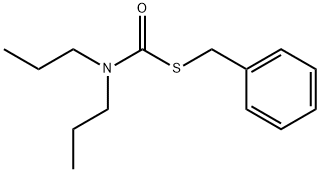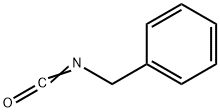Benzyl mercaptan
Synonym(s):α-Toluenethiol;α-Tolyl mercaptan;Benzenemethanethiol
- CAS NO.:100-53-8
- Empirical Formula: C7H8S
- Molecular Weight: 124.2
- MDL number: MFCD00004867
- EINECS: 202-862-5
- SAFETY DATA SHEET (SDS)
- Update Date: 2024-12-18 13:37:16

What is Benzyl mercaptan?
Chemical properties
Cream to white, moist crystals; musty odor. Insoluble in water; soluble in alcohol or ether. There are three isomers with different boiling points.
Chemical properties
Benzyl mercaptan has repulsive, garlic-like odor. It oxidizes in air to dibenzyl disulfide.
Occurrence
Reported found in coffee.
The Uses of Benzyl mercaptan
Benzyl mercaptan can be used as:
- A nucleophilic reagent in the cleavage of proanthocyanidins into their constitutive subunits.
- A reactant in the synthesis of dithiocarboxylic esters in the presence of phosphorus pentasulfide as a catalyst.
- A modifier to functionalize the surface of CNT for enhanced interaction with Pt-nanoparticles.
The Uses of Benzyl mercaptan
Intermediate, bacteriostat.
What are the applications of Application
Benzyl mercaptan is a common laboratory alkylthiol, which can be used as a source of thiol function
Preparation
From benzyl chloride and potassium hydrosulfide.
Definition
ChEBI: Benzyl thiol is a thiol that is toluene in which one of the methyl hydrogens has been replaced by a sulfanyl group. It has a role as a plant metabolite. It is a thiol and a member of benzenes. It derives from a hydride of a toluene.
Aroma threshold values
Detection: 0.19 to 2.6 ppb.
Taste threshold values
Taste characteristics at 15 ppm: leek, horseradish, cabbage, green, tomato and coffee.
Synthesis Reference(s)
Canadian Journal of Chemistry, 53, p. 1480, 1975 DOI: 10.1139/v75-205
Synthesis, p. 498, 1984 DOI: 10.1055/s-1984-30880
Hazard
Skin irritant.
Safety Profile
Poison by inhalation and intraperitoneal routes. Moderately toxic by ingestion. An eye irritant. Questionable carcinogen with experimental tumorigenic data. Flammable when exposed to heat or flame. Can react vigorously with oxidizing materials. To fight fire, use foam, CO2, dry chemical, water spray, mist, fog. When heated to decomposition and on contact with acid or acid fumes it emits highly toxic fumes of SOx. See also SULFIDES and MERCAPTANS.
Purification Methods
Purify benzyl mercaptan via the mercury salt [see Kern J Am Chem Soc 75 1865 1953], which crystallises from *benzene as needles (m 121o), and then dissolve it in CHCl3. Pass H2S gas through the solution to regenerate the mercaptan. The HgS that precipitates is filtered off and washed thoroughly with CHCl3. The filtrate and washings are evaporated to remove CHCl3; then the residue is fractionally distilled under reduced pressure [Mackle & McClean, Trans Faraday Soc 58 895 1962]. [Beilstein 6 IV 2632.]
Properties of Benzyl mercaptan
| Melting point: | -29 °C |
| Boiling point: | 194-195 °C (lit.) |
| Density | 1.058 g/mL at 25 °C (lit.) |
| vapor density | >4 (vs air) |
| refractive index | n |
| FEMA | 2147 | BENZYL MERCAPTAN |
| Flash point: | 158 °F |
| storage temp. | 2-8°C |
| solubility | Chloroform (Slightly), Methanol (Slightly) |
| pka | 9.43(at 25℃) |
| form | Liquid |
| color | Clear colorless to light yellow |
| Odor | at 0.10 % in propylene glycol. sharp alliaceous onion sulfurous garlic horseradish mint coffee |
| explosive limit | 1%(V) |
| Water Solubility | Not miscible or difficult to mix in water. |
| Sensitive | Air Sensitive |
| Merck | 14,9322 |
| JECFA Number | 526 |
| BRN | 605864 |
| Stability: | Stable. Combustible. |
| CAS DataBase Reference | 100-53-8(CAS DataBase Reference) |
| NIST Chemistry Reference | Benzenemethanethiol(100-53-8) |
| EPA Substance Registry System | Benzenemethanethiol (100-53-8) |
Safety information for Benzyl mercaptan
| Signal word | Danger |
| Pictogram(s) |
 Skull and Crossbones Acute Toxicity GHS06  Environment GHS09 |
| GHS Hazard Statements |
H302:Acute toxicity,oral H330:Acute toxicity,inhalation H410:Hazardous to the aquatic environment, long-term hazard |
| Precautionary Statement Codes |
P260:Do not breathe dust/fume/gas/mist/vapours/spray. P264:Wash hands thoroughly after handling. P264:Wash skin thouroughly after handling. P270:Do not eat, drink or smoke when using this product. P273:Avoid release to the environment. P301+P312:IF SWALLOWED: call a POISON CENTER or doctor/physician IF you feel unwell. |
Computed Descriptors for Benzyl mercaptan
| InChIKey | UENWRTRMUIOCKN-UHFFFAOYSA-N |
New Products
(S)-3-Aminobutanenitrile hydrochloride 4-Methylphenylacetic acid N-Boc-D-alaninol N-BOC-D/L-ALANINOL Tert-butyl bis(2-chloroethyl)carbamate 3-Morpholino-1-(4-nitrophenyl)-5,6-dihydropyridin- 2(1H)-one Furan-2,5-Dicarboxylic Acid Tropic acid 1-Bromo-3,5-Di-Tert-Butylbenzene S-2-CHLORO PROPIONIC ACID ETHYL ISOCYANOACETATE 2-Bromo-1,3-Bis(Dimethylamino)Trimethinium Hexafluorophosphate 4-IODO BENZOIC ACID 3-NITRO-2-METHYL ANILINE 1-(2,4-DICHLOROPHENYL) ETHANAMINE (2-Hydroxyphenyl)acetonitrile 4-Bromopyrazole 2-(Cyanocyclohexyl)acetic acid 4-methoxy-3,5-dinitropyridine 1-(4-(aminomethyl)benzyl)urea hydrochloride 2-aminopropyl benzoate hydrochloride diethyl 2-(2-((tertbutoxycarbonyl)amino) ethyl)malonate tert-butyl 4- (ureidomethyl)benzylcarbamate Ethyl-2-chloro((4-methoxyphenyl)hydrazono)acetateRelated products of tetrahydrofuran




![2-Ethylhexyl 10-ethyl-4-[[2-[(2-ethylhexyl)oxy]-2-oxoethyl]thio]-4-methyl-7-oxo-8-oxa-3,5-dithia-4-stannatetradecanoate](https://img.chemicalbook.in/CAS/GIF/57583-34-3.gif)



You may like
-
 Benzyl mercaptan, Polymer supported, 1% cross-linked, 2.0 to 4.0 mmol/g on poly(styrene-divinylbenzene) CAS 100-53-8View Details
Benzyl mercaptan, Polymer supported, 1% cross-linked, 2.0 to 4.0 mmol/g on poly(styrene-divinylbenzene) CAS 100-53-8View Details
100-53-8 -
 Benzyl Mercaptan CAS 100-53-8View Details
Benzyl Mercaptan CAS 100-53-8View Details
100-53-8 -
 Benzyl mercaptan CAS 100-53-8View Details
Benzyl mercaptan CAS 100-53-8View Details
100-53-8 -
 1975-50-4 98%View Details
1975-50-4 98%View Details
1975-50-4 -
 2-HYDROXY BENZYL ALCOHOL 98%View Details
2-HYDROXY BENZYL ALCOHOL 98%View Details
90-01-7 -
 2-Chloro-1,3-Bis(Dimethylamino)Trimethinium Hexafluorophosphate 221615-75-4 98%View Details
2-Chloro-1,3-Bis(Dimethylamino)Trimethinium Hexafluorophosphate 221615-75-4 98%View Details
221615-75-4 -
 14714-50-2 (2-Hydroxyphenyl)acetonitrile 98+View Details
14714-50-2 (2-Hydroxyphenyl)acetonitrile 98+View Details
14714-50-2 -
 118753-70-1 98+View Details
118753-70-1 98+View Details
118753-70-1